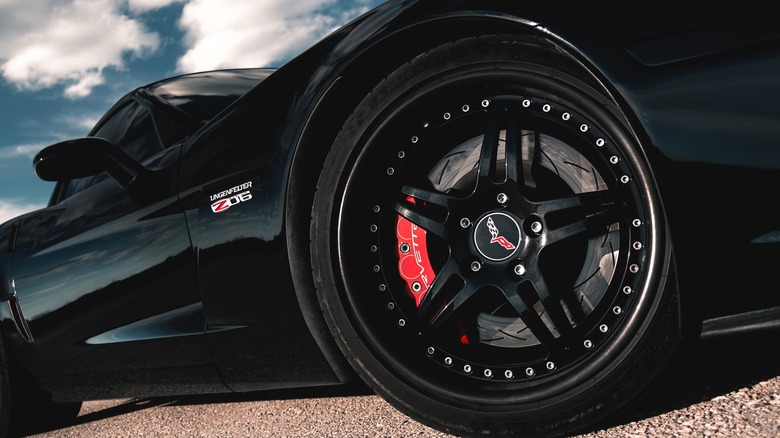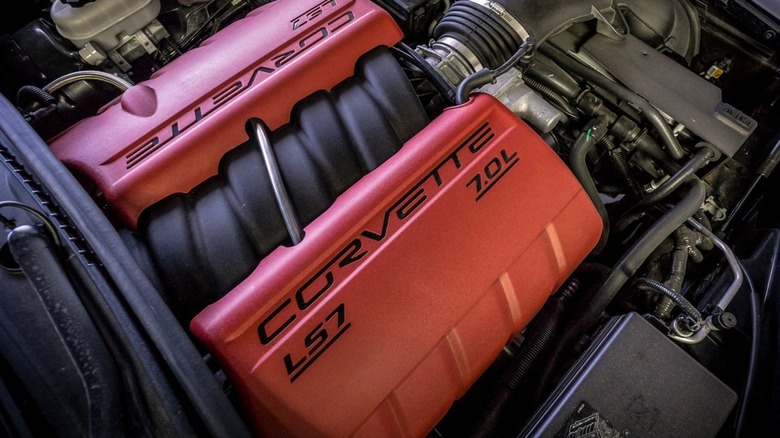GM's LS3 Vs. LS7 Engine: What's The Difference Between Them?
The small-block Chevrolet (SBC) V8 has undergone several refinements over the decades since its creation. While every true SBC generation uses the same 4.40-inch cylinder bore spacing, single camshaft, and pushrod-driven valvetrain, few specimens rival the popularity of the fourth-generation LS engine lineup. However, the similarities with Gen III LS engines, including their lightweight aluminum engine block and cylinder head construction, make them popular as well.
The two most popular and powerful naturally aspirated Gen IV LS engines are the LS3 and LS7, which powered different versions of Chevrolet's C6 Corvette. At the time of their introductions, the Gen IV LS3 and LS7 each represented leaps in horsepower gain over their predecessors. Of course, there are LS engines with more horsepower and torque, such as the LSA and LS9, but those examples used forced air induction supercharger systems. In contrast, the LS3 and LS7 achieved their power via naturally aspirated fuel induction systems. With the similarities between the LS3 and LS7 out of the way, let's explore what makes them different.
LS3 usage and specs
The Gen IV LS3 from General Motors debuted in the 2008 Chevrolet C6 Corvette. From 2008 to 2013, the LS3-powered Corvette equipped with standard exhaust made 430 horsepower at 5,900 rpm and 424 lb-ft of torque at 4,600 rpm. During the same time period, Chevy offered an optional exhaust system for the C6 Corvette, which increased the LS3's horsepower to 436 and torque to 428 lb-ft at the same rpm values.
In 2009, Chevrolet used the LS3 in six-speed manual transmission Camaro SS Coupe and Convertible models. The Camaro SS LS3 received a lower power rating than the Corvette version, with 426 horsepower at 5,900 rpm and 420 lb-ft of torque at 4,600 rpm. GM discontinued the LS3 option for the Camaro SS in 2015 but lingered on with 415 horsepower and 415 lb-ft of torque in the little-known Chevy SS, a rear-wheel-drive performance sedan, until 2017.
The LS3 displaces 6.2 liters (376 cubic inches) thanks to its 103.25 mm (4.065-inch) cylinder bores and 93 mm (3.622-inch) crankshaft stroke. Hypereutectic aluminum pistons and cast aluminum cylinder heads with 68cc combustion chambers combine to produce a compression ratio of 10.7:1.
How is the LS7 different than the LS3?
The most notable differences between the LS3 and LS7 are the latter's larger displacement, at 7.0 liters (427.6 cubic inches), and its increased power output. The LS7 debuted three years after the LS3 and was also used in the C6 Corvette. It powered 2011 through 2013 Chevrolet Corvette Z06 coupes and a special 2013 Corvette 427 convertible model, producing 505 horsepower at 6,800 rpm and 470 lb-ft of torque at 4,800 rpm in either version.
In a rare twist, GM also used the LS7 in the Chevrolet Camaro Z/28 from 2014 to 2015. While the usage isn't surprising, the fact that the Z/28's LS7 received the same horsepower rating and 11 additional lb-ft of torque compared to the Z06 might be unexpected.
The LS7 features cylinder heads with 70cc combustion chambers combined with a valve-relieved flat-top piston for an 11.0:1 compression ratio. In addition to the higher compression ratio, the LS7 has larger 104.8 mm (4.125-inch) cylinder bores and a longer 101.6 mm (4.00-inch) crankshaft stroke.


